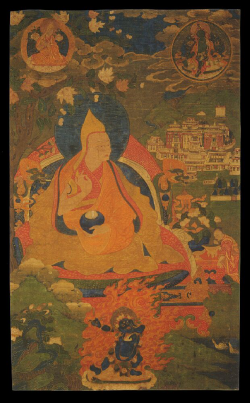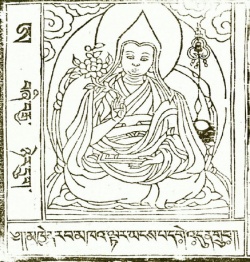The Dalai Lama Line
Biography and autobiography in Tibet are important sources for both education and inspiration. The authors involved in the Treasury of Lives mine primary sources to provide English-language biographies of every known religious teacher from Tibet and the Himalaya, all of which are organized on their website. The following summarizes the biography of the 1st Dalai Lama, Gendun Drub, by Miranda Adams.
At the Treasury of Lives we are fascinated by the remarkable details, human accounts, and historical truths revealed in life writing. In this series, we will be exploring the Dalai Lama incarnation line, revealing little known details and stories that might surprise.
The Dalai Lama incarnation line is one of the most famous and important in Tibet. While the most well known Dalai Lamas are the 5th, Ngawang Lobzang Gyatso (1617–1682), and the present Dalai Lamae 14th Dalai Lama, Tenzin Gyatso (b. 1935), many Dalai Lama incarnations lived incredibly interesting and influential lives.
The 1st Dalai Lama, Gendun Drub (1391–1474) was posthumously identified as the 1st Dalai Lama after the 3rd Dalai Lama, Sonam Gyatso (1543–1588), was given the title more than 150 years later. Gendun Drub was born to a family of nomadic farmers in 1391 near Sakya in Tsang. According to local folklore, on the night he was born, bandits attacked the family’s camp, and his mother, fearing for the life of her newborn child, wrapped him in blankets and hid him among the rocks before fleeing for her life. Upon her return the next morning, she found her son resting peacefully among the stones, with a large black raven standing guard before him, protecting him from the flocks of crows and wild vultures that had gathered to attack. The raven is said to have been an emanation of Mahākāla, who would become Gendun Drub’s personal deity.
Gendun Drub’s father died when he was 7, at which time his mother sent him to Nartang Monastery to begin his education. When he entered the monastery he was given the name Pema Dorje. At 15 he took novice vows, receiving the name Gendun Drubpa Pel, and became a fully ordained monk at age 20.
In 1415, when he was 25, Gendun Drub traveled to U where he met Tsongkhapa Lobzang Drakpa (1357–1419), the founder of the Gelug school to which the Dalai Lama line belongs, and remained at Ganden for roughly 12 years, even though Je Tsongkhapa passed away only four years after their initial meeting. It is said that Tsongkhapa gave Gendun Drub a piece of his own monastic robes upon their meeting, a gesture denoting the close tie and mutual respect the two lamas shared.
For 12 years Gendun Drub and his teacher Sherab Sengge (1383–1445) traveled together, visiting Sakya and Kadam monasteries in Tsang and spreading Tsongkhapa’s Lamrim teachings. Because Gendun Drub taught widely for 50 years, he trained countless abbots of Kadam and Geluk monasteries across Tibet, and even those of some Sakya monasteries.
In 1432 Gendun Drub became the abbot of the Sakya monastery Tanak Riku, transforming it into a Geluk monastery. He also built a residence at Jangchen Monastery attracting a large number of students there.
Gendun Drub founded Tashilhunpo in 1447 in Shigatse, Tsang, an outpost of Geluk teachings in a region that was then largely dominated by Sakya and Kagyu monasteries. It is said that the Sakya master Tangtong Gyelpo (1361–1485) attempted to prevent him from establishing the new monastery. Surely, Tangtong Gyelpo’s disapproved of the overwhelming influence that the Geluk school would subsequently have in the region, where Gendun Drub went on to establish three religious colleges.
Gendun Drub was extremely influential in spreading the Geluk tradition throughout Tibet. Indeed, among his extensive commentaries are three on the Vinaya, considered among the most influential in the lineage today.
In 1474, at the age of 84, Gendun Drub passed away at Tashilhunpo Monastery.
Asha Kaufman is an arts and museum professional with a specialty in Himalayan art and culture. She has a Masters from Harvard Divinity School and serves as Manager of Outreach and Development at the Treasury of Lives.

